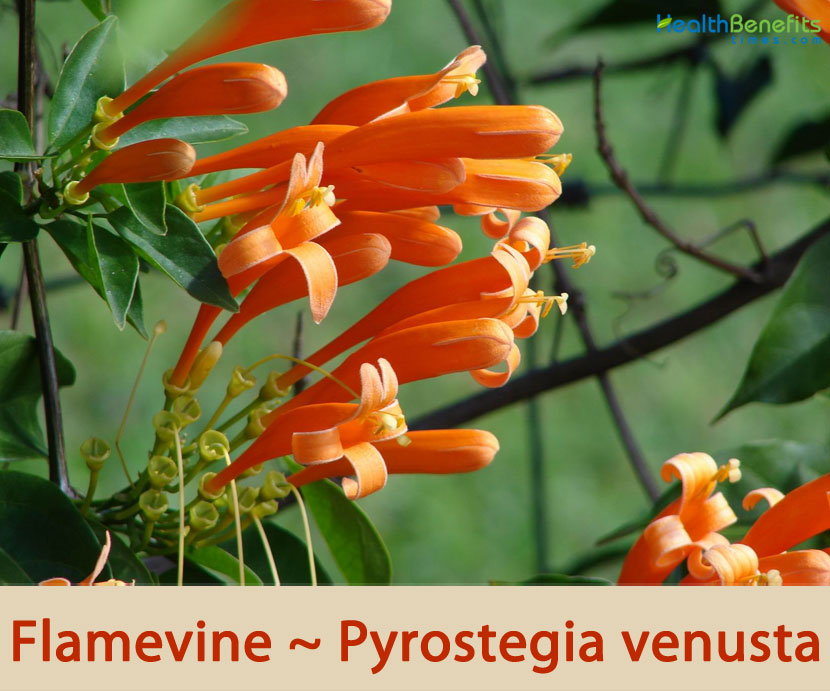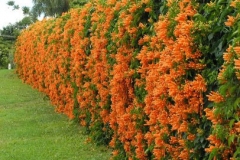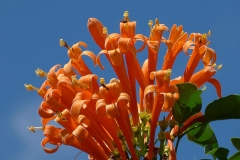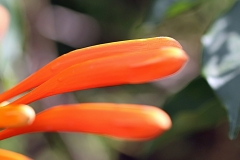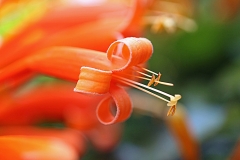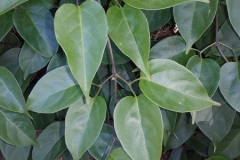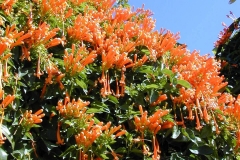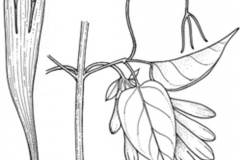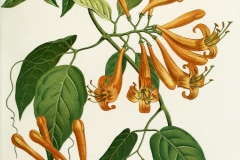| Flamevine Quick Facts | |
|---|---|
| Name: | Flamevine |
| Scientific Name: | Pyrostegia venusta |
| Origin | South America (i.e. Brazil, Bolivia, north-eastern Argentina and Paraguay) |
| Colors | Light brown |
| Shapes | Slender dry capsules about 1 ft long |
| Health benefits | Bronchitis, flu and cold, diarrhea, vitiligo, jaundice, dysentery and wound healing |
| Name | Flamevine |
|---|---|
| Scientific Name | Pyrostegia venusta |
| Native | South America (i.e. Brazil, Bolivia, north-eastern Argentina and Paraguay). Occasionally naturalized in eastern Australia (i.e. in south-eastern Queensland and the coastal districts of central and northern New South Wales). Also naturalized overseas in eastern Africa (i.e. Tanzania) and south-eastern USA (i.e. Florida) |
| Common Names | Flame flower, flame vine, flaming trumpet vine, orange creeper, orange trumpet vine, Flaming trumpet, Golden shower trumpet, Orange Bignonia, flame creeper, flame flower vine, golden shower, golden shower vine, golden showers, orange creeper vine, orange trumpet creeper, Chinese cracker flower, belas, Flame vine, Orange trumpet |
| Name in Other Languages | Bengali: Kamalā ḍhāka latā (কমলা ঢাক লতা) Brazil: Cipo-de-Sao-Joao Chinese: Pao zhang hu ( 炮仗花) Dutch: Oranje stephanoot English: Golden shower, Flamevine, Orange trumpetvine, Orange-creeper, Flame vine, Chinese cracker flower, sweetheart vine Finnish: Tulitrumpetti French: Liane aurore, Bignone du Bresil, liane-de-feu German: Feuer auf dem Dach, Feuerranke Hawaiian: Huapala Malayalam: Januvari mulla (ജനുവരി മുല്ല) Marathi: Sankraantavel (संक्रांतवेल) Paraguay: Yvyrati Portuguese: Cipó-de-são-joão, cipo-de-fogo; flor-de-Sao-Joao, bignonia, flor-de-fogo, gaitas, gaitinhas Russian: Pirostegiya ognennaya (пиростегия огненная), pirostegiya prekrasnaya (пиростегия прекрасная) Spanish: Tango, chiltote, chorro de oro, San Carlos, triquitraque Swedish: Flamranka Tamil: Tanga pu (தந்கா பூ) Thai: Phwngs̄æd (พวงแสด) Tongan: Talupite ulo |
| Plant Growth Habit | Vigorous, fast-growing, evergreen woody vine |
| Growing Climates | Rocky places, forests in seasonally dry areas, scrub |
| Soil | Prefers compost enriched, light and moist, but well-drained soil. It tolerates many kind of soils: acidic, alkaline, clayey, sandy or loamy, but is intolerant of saline soils |
| Plant Size | 5-7 m in length |
| Stem | Stems are angular to sub-cylindrical, striate, puberulent or lepidote, interpetiolar zone not glandular; cross section of the mature stem with peripheral phloem tissue not forming a cross |
| Leaf | Compound leaves have two or three 2-3 in oval leaflets and are arranged in pairs opposite each other on the stem. Often, the center leaflet is modified into a coiled, three-parted tendril |
| Flowering season | February, March, April |
| Flower | Tubular flowers are about 3 in long and borne in clusters of 15-20 at the tips of branches. Calyx is 4–7 mm long, almost entire to shallowly lobed and minutely 5-dentate |
| Fruit Shape & Size | Slender dry capsules about 1 ft long |
| Fruit Color | Light brown |
| Propagation | Easily propagated vegetatively from semi-hard cuttings, suckers or layering. Also, by seed germination |
| Plant Parts Used | Roots, flowers |
Plant Description
Flamevine is a vigorous, fast-growing, evergreen woody flowering vine that normally grows about 5-7 m tall. The plant can spread quickly by tendrils to the top of whatever supports it, including fences, other plants or even small buildings by branching profusely and climbing using its clinging tendrils. The plant is found growing in rocky places, forests in seasonally dry areas and scrub. The plant prefers compost enriched, light and moist, but well-drained soil. It tolerates several kinds of soils: acidic, alkaline, clayey, sandy or loamy, but is intolerant of saline soils. Stems are angular to sub-cylindrical, striate, puberulent or lepidote, interpetiolar zone not glandular; cross section of the mature stem with peripheral phloem tissue not forming a cross. Flame Vine has been listed as possibly invasive in some regions as it can easily regrow from its roots even if damaged above ground.
Leaves
Leaves are opposite, compound 4–10 cm long often with terminal leaflet modified into a coiled 3-branched tendril 5–15 cm long; leaflets 2 (or 3) are ovate to lanceolate or ovate-elliptic/oblong, mostly 3–9 cm long and 2–4.5 cm wide, glabrous. Often, the center leaflet is modified into a coiled, three-parted tendril. Apex is acuminate with entire margin. Petiole is 5–15 cm long, sparsely hairy and petiolules is 5–15 mm long. There may be a combination of compound-bifoliate leaves (often with a tendril between folioles/leaflets) and trifoliate leaves; the 3-tipped tendrils often coiling but absent from many leaves. They’re arranged in pairs, opposite each other on the woody and slender stems and sprawling branches.
| Leaf arrangement | Opposite/sub opposite |
| Leaf type | Palmately compound |
| Leaf margin | Entire |
| Leaf shape | Ovate |
| Leaf venation | Pinnate |
| Leaf type and persistence | Evergreen |
| Leaf blade length | 2 to 4 inches |
| Leaf color | Green |
| Fall color | No fall color change |
| Fall characteristic | Not showy |
Flowers
Orange Trumpet Creeper is a floriferous climber that flowers almost continuously throughout the year in the tropics, and in the subtropics from late fall to spring, even lightly during summer. The tubular flowers are about 3 in long and borne in clusters of 15-20 at the tips of branches. Calyx is 4–7 mm long, almost entire to shallowly lobed and minutely 5-dentate. Corolla usually 5–7 cm long, orange or reddish orange; tube ± curved, very narrow at base, broadening above; lobes 10–18 mm long, margin and often upper parts of outer and/or inner surfaces hairy. The flower clusters may hang down under the weight of their own beauty. The long-lasting, brilliantly colored and attractive flowers are a magnet for hummingbirds, bumble bees and butterflies too!
| Flower color | Orange |
| Flower characteristic | Winter flowering; fall flowering |
Fruits
Fertile flowers are followed by narrow, light brown, cylindrical dry capsules about 1 ft. long, with the mid vein slightly prominent. Seeds are numerous, 1.2-1.4 cm long, wings brown with the margins hyaline that can be used for propagation.
| Fruit shape | Elongated |
| Fruit length | 6 to 12 inches |
| Fruit cover | Dry or hard |
| Fruit color | Unknown |
| Fruit characteristic | Inconspicuous and not showy |
Traditional Uses and benefits of Flamevine
- It has been used in traditional folk medicine as a remedy for treating white patches and infections on the skin (leukoderma, vitiligo).
- Native Brazilians use the aerial parts of Pyrostegia venusta for the treatment of cough and common diseases of the respiratory system related to infections, such as bronchitis, flu and cold.
- An infusion is used to treat diarrhea, vitiligo and jaundice.
- Tonics made from the stems of this plant are useful for the treatment of diarrhea, whereas flower preparations have been shown to atttenuate vomiting.
- Extracts have been used in the treatment of different skin diseases; it may be useful in the tropical management of wound healing.
- Leaves are used in traditional medicine as a tonic and for treating diarrhea in Brazil.
- It is used as a tonic and antidiarrheal in Iracambi.
- In Brazil, used as general tonic to treat any inflammatory disease; also for diarrhea, dysentery, leucoderma and vitiligo, and common diseases of the respiratory tract, such as bronchitis, flu, and cold.
- It is also drunk as a general tonic and used as an antidepressant.
- In folk medicine, its parts are used for the treatment of inflammatory respiratory diseases.
Other Facts
- Flame vine grows rapidly covering trees, fences, and other structures and should be avoided as an ornamental or landscape plant.
- It is also useful to cover necessary but unsightly garden features like water tanks and old garden sheds.
- This plant is attractive to bees, butterflies and birds like the Greater double-collared sunbird.
References:
https://www.itis.gov/servlet/SingleRpt/SingleRpt?search_topic=TSN&search_value=34324#null
http://www.hear.org/pier/species/pyrostegia_venusta.htm
http://www.theplantlist.org/tpl1.1/record/kew-317830
https://en.wikipedia.org/wiki/Pyrostegia_venusta
https://plants.usda.gov/core/profile?symbol=PYVE2
http://www.flowersofindia.net/catalog/slides/Flaming%20Trumpet.html
http://colplanta.org/taxon/urn:lsid:ipni.org:names:110483-1
https://www.cabi.org/isc/datasheet/46074
https://gd.eppo.int/taxon/PYRVE
https://edis.ifas.ufl.edu/fp496
http://tn-grin.nat.tn/gringlobal/taxonomydetail.aspx?id=402034
https://plantnet.rbgsyd.nsw.gov.au/cgi-bin/NSWfl.pl?page=nswfl&lvl=sp&name=Pyrostegia~venusta
http://en.xtbg.ac.cn/rs/ma/201303/t20130312_99553.html
https://davesgarden.com/guides/pf/go/53032/#b


